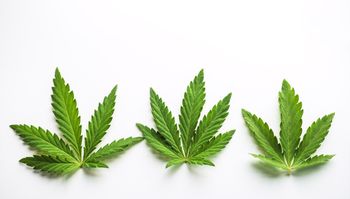
Cannabis Science and Technology
- November/December 2018
- Volume 1
- Issue 4
Leveraging Selectivity and Efficiency to Take the Strain Out of LC–UV Method Development for Cannabinoid Profiling
Here the LC–UV separation of 16 cannabinoids of interest was performed while the potential impact from minor cannabinoids and terpenes on reported potency values was monitored.
More than 100 cannabinoids have been isolated from cannabis in addition to the five most commonly tested: â9-tetrahydrocannabinol (â9-THC), â9-tetrahydrocannabinolic acid (THCA), cannabidiol (CBD), cannabidiolic acid (CBDA), and cannabinol (CBN). Although many methods have been published that show the separation of these major cannabinoids, most do not take into account the possibility of interference from minor cannabinoids. This interference is most problematic in concentrates where minor cannabinoids can be enriched to detectable levels. Additionally, some terpenes absorb ultraviolet (UV) light at the same wavelength as cannabinoids, which can result in an additional source of interference. In this study, the liquid chromatography (LC)–UV separation of 16 cannabinoids of interest was performed while the potential impact from minor cannabinoids and terpenes on reported potency values was monitored. The method was applied to commercially available CBD oils that have recently become suspect because of inaccurate label claims.
Just as consumers rely on nutrition facts labels on food for making informed choices about their diets, labels on cannabis products are intended to provide critical information for accurate dosing. Consumer confidence in labeling claims can be shattered by reports of inaccuracies. A recent study published by the Journal of the American Medical Association showed that of 84 cannabidiol (CBD) products purchased online, only 31% were accurately labeled (1). This labeling problem is alarming since cannabinoids such as CBD and â9-tetrahydrocannabinol (â9-THC) have been found to be very effective for the treatment of various medical disorders; however, accurate dosing is required for positive patient outcomes. As examples, CBD was determined to be an effective treatment for those suffering from treatment-resistant epilepsy while â9-THC has been found to be an effective treatment for pain when coadministered with reduced doses of opioids (2,3). Whether labeling inaccuracies stem from inadequate analytical methods, instability of formulations, or surreptitious laboratory practices, all result in the same potentially negative impact to the health and safety of consumers.
Although the state of analytical testing in the cannabis industry has improved since the inception of legalized medical cannabis, there are still many opportunities to update existing methods in this dynamic market. Historically, interest in cannabinoids typically focused on THC, CBD, and their carboxylated forms, but the analysis of more-abundant minor cannabinoids is starting to gather momentum. Testing laboratories most frequently use liquid chromatography (LC)-based techniques paired with ultraviolet (UV) detection for cannabinoid profiling because of its low initial cost, ease of use, and robustness. Because UV detection is limited in its spectral deconvolution abilities, chromatography plays a critical role in not only cannabinoid identification, but also accurate quantitation. The demands on the analytical column are only made more difficult considering the complexity of the matrix. Cannabis is a complex matrix that contains more than 100 cannabinoids as well as hundreds of additional components including terpenes, fatty acids, sugars, flavonoids, and pigments (4). The introduction of cannabis concentrates into additional matrices to create cannabis-infused products further complicates analysis. If product labels are to accurately reflect cannabinoid content, the complete sample composition must be considered in developing a robust and accurate analytical method. Herein, the process of developing a complete workflow solution for the analysis of cannabinoids is discussed with emphasis on LC–UV conditions, sample preparation strategies, method applications, and high-throughput enabling technologies.
Development of LC Method Conditions
Method development began with the goal of achieving baseline resolution for the following 16 cannabinoids by LC–UV: â9-THC, â9-tetrahydrocannabinolic acid (THCA), CBD, cannabidiolic acid (CBDA), cannabinol (CBN), cannabidivarinic acid (CBDVA), cannabidivarin (CBDV), cannabigerolic acid (CBGA), cannabigerol (CBG), tetrahydrocannabivarin (THCV), tetrahydrocannabivarinic acid (THCVA), cannabinolic acid (CBNA), â8-tetrahydrocannabinol (â8-THC), cannabicyclol (CBL), cannabichromene (CBC), and cannabichromenic acid (CBCA). A 150 mm x 4.6 mm C18-type column packed with 2.7-µm superficially porous particles (SPPs) was initially scouted using popular mobile phases for the analysis of cannabinoids (water and acetonitrile modified with 0.1% formic acid) with UV detection at 228 nm. C18-type columns are ideal for the separation of cannabinoids because of their hydrophobic and shape-selective characteristics. The combination of the appropriate stationary phase with SPPs increases the speed and improves resolution compared to traditional fully porous particles (FPPs) of the same particle size. The use of a 150 mm x 4.6 mm analytical column allows for the most efficient separations under the constraints of legacy instrumentation. Using isocratic conditions it was found that 14 of the 16 cannabinoids could be baseline resolved; however, CBNA was coeluted with â9-THC regardless of flow rate, column temperature, or mobile-phase composition.
In an attempt to separate CBNA from â9-THC, the pH of the mobile phases was adjusted by using 0.1% acetic modified mobile phases in place of formic acid. This strategy was attempted in an effort to take advantage of the pKa of CBNA because it would be less retained in its ionized form, but THC would not be impacted as a neutral compound. Ionized compounds are more polar and not as strongly retained by reversed-phase mechanisms. The use of acetic acid maintained the same selectivity and resolution of the original separation, but still resulted in the coelution of CBNA and â9-THC. The pH of the mobile-phase system was further increased by the use of water modified with 5 mM ammonium formate and unmodified acetonitrile. This approach resulted in a loss of retention for all acidic cannabinoids because of the ionization of carboxylic acid functional groups. To reach an intermediate pH, the aqueous mobile phase was modified with both 0.1% formic acid and 5 mM ammonium formate, whereas the organic mobile phase was modified with only 0.1% formic acid. These mobile phases combined with a 1.5 mL/min flow rate using 75% organic allowed for the partial resolution of CBNA from â9-THC while still maintaining the separation of the remaining 14 cannabinoids. To this point, a column oven temperature of 40 °C had been used for method development. To enhance the shape selective characteristics of the stationary phase, the column oven temperature was reduced to 30 °C. This adjustment resulted in the baseline separation of all 16 cannabinoids with a complete cycle time of 9 min (Figure 1). (See upper right for Figure 1, click to enlarge. Figure 1: The separation of 16 cannabinoids by HPLC–UV. Column: 150 mm x 4.6 mm, 2.7-µm Raptor ARC-18; mobile-phase A: water, 0.1% formic acid (v/v), 5 mM ammonium formate; mobile-phase B: acetonitrile, 0.1% formic acid (v/v); elution: isocratic at 75% B over 9 min; flow rate = 1.5 mL/min; injection volume: 5 µL; oven temperature: 30 °C; detection: UV absorbance at 228 nm. Peaks: 1 = CBDVA, 2 = CBDV, 3 = CBDA, 4 = CBGA, 5 = CBG, 6 = CBD, 7 = THCV, 8 = THCVA, 9 = CBN, 10 = CBNA, 11 = â9-THC, 12 = â8-THC, 13 = CBL, 14 = CBC, 15 = â9-THCA, 16 = CBCA.)
Additional Sources of Interference
During LC method development, it was determined that minor cannabinoids can affect the quantitation of the major cannabinoids CBD and â9-THC. Another class of compounds found in cannabis, terpenes, can also be present in high enough concentrations to interfere with sample analysis. A mix of 21 common terpenes found in cannabis was prepared and injected using the same conditions as previously developed for cannabinoids. Fortunately, the absorbance profile for most terpenes differs from cannabinoids such that they do not result in over reporting for cannabinoids. The terpenes that absorb UV light best at 228 nm, ocimene and its isomers, do not interfere with the quantitation of any monitored cannabinoid. Minor terpene interferences were found that could impact the quantitation of CBGA and THCVA if present in substantial concentrations, but the quantitative analysis of these cannabinoids is not currently required in states such as California and Colorado (5,6).
Sample Preparation
The utility of the chromatographic method was evaluated by performing quantitative analysis of CBD in commercially available hemp-derived CBD oils. Calibration standards and quality control (QC) samples were prepared in 25:75 water–methanol across a linear range of 5–500 µg/mL. A QC dilution sample was prepared at 1000 µg/mL and diluted 20-fold to demonstrate the validity of diluting samples into the linear range. Six hemp-derived CBD oils were obtained for analysis. These products consisted of three vape oils, two sublingual oils, and one raw hemp oil. Next, 50 µL of CBD product was extracted using 950 µL of methanol followed by vortexing for 30 s at 3000 rpm. After that, 750 µL of the sample was then mixed with 250 µL of water followed by vortexing for 10 s at 3000 rpm. Finally, 400 µL of the sample was filtered using a Thomson Single Step standard filter vial with a 0.2-µm polyvinylidene fluoride (PVDF) membrane before LC–UV analysis.
Results and Discussion
Using linear 1/x weighted regression, the method showed good linearity for CBD with an r2 value of 0.999. The method accuracy was demonstrated to be within 4% of the nominal concentration for all QC levels. The percent relative standard deviation (%RSD) was within 3.14% for all QC levels indicating good method precision (Table I). (See upper right for Table I, click to enlarge. Table I: Inter-run accuracy and precision (n = 6).) According to California regulations, a cannabis product must not differ from the labeled concentration of CBD by ±10% (5). Applying this labeling guideline to the samples evaluated in this study results in the possibility of all six products not being in compliance with these regulations (Table II). (See upper right for Table II, click to enlarge. Table II: Determined concentrations of CBD in commercially available hemp-derived CBD oils.) One product failure is attributed strictly to labeling nomenclature as the CBD content is not directly stated. Vape oils did not contain a significant amount of CBDA to account for the discrepancy in the labeling. The large discrepancy in the result for Product 3 is most likely because of photodegradation from improper packaging. In addition to CBD, other cannabinoids were found in most samples. Additional cannabinoids that were found included: CBDVA, CBDV, CBDA, CBG, â9-THC, â8-THC, CBN, CBNA, and CBC. The concentrations of these cannabinoids were not quantitatively evaluated because of their relative low abundance, but the concentration of â9-THC in all samples appeared to be well below 0.3% w/w based upon the peak height of a 50-µg/mL standard allowing the use of THC-free labels.
To ensure that sample results were not skewed because of poor extraction efficiencies, a recovery experiment was performed by spiking each product type with an additional 2.00 mg/mL of CBD. Recovery results for vape oil, sublingual oil, and raw hemp oil were 102%, 98.5%, and 105%, respectively.
With regard to sample preparation, it should be emphasized that the addition of water following extraction with methanol is critical to precipitate lipids that are present in raw hemp oils and common carrier oils for sublingual products (that is, coconut medium-chain triglycerides [MCT] oil, sunflower oil, sesame oil, and so forth). Failure to perform this step will cause sample precipitation to occur once introduced into the mobile phase during high performance liquid chromatography (HPLC) analysis. The inlet frit of the analytical column will quickly clog resulting in elevated back pressures and decreased column lifetime. It is important to not combine the addition of water into the extraction step with methanol because this has been shown to result in reduced recoveries for cannabinoids in cannabis oils (7).
Ultrahigh-Pressure Liquid Chromatography Analysis
To improve laboratory throughput, the efficiency of sub-2 µm SPPs can be used to increase the speed of analysis while maintaining the same resolution. By pairing an appropriate system to a 100 mm x 3.0 mm analytical column packed with 1.8-µm SPPs of the same stationary phase, the separation can be achieved in 4 min (Figure 2). (See upper right for Figure 2, click to enlarge. Figure 2: The separation of 16 cannabinoids by UHPLC–UV. Column: 100 mm x 3.0 mm, 1.8-µm Raptor ARC-18; mobile-phase A: water, 0.1% formic acid (v/v), 5 mM ammonium formate; mobile-phase B: acetonitrile, 0.1% formic acid (v/v); elution: isocratic at 75% B over 4 min; flow rate = 1.0 mL/min; injection volume: 1 µL; oven temperature: 30 °C; detection: UV absorbance at 228 nm. Peaks: 1 = CBDVA, 2 = CBDV, 3 = CBDA, 4 = CBGA, 5 = CBG, 6 = CBD, 7 = THCV, 8 = THCVA, 9 = CBN, 10 = CBNA, 11 = â9-THC, 12 = â8-THC, 13 = CBL, 14 = CBC, 15 = THCA, 16 = CBCA.) This approach results in a cycle time that is more than twice as fast with a 70% reduction in consumed mobile phase per sample. Columns must be effectively paired to an appropriate LC system that is not only robust at high system back pressures, but also optimized to reduce extra column volumes. Any dispersion that occurs in the valves, connecting tubing, and flow cell will reduce the efficiency and the resolution of separations. It is particularly important to use low-volume flow cells (approximately 1 µL) because of the relatively large volumes present in standard flow cells (8).
Conclusions
Considering the structural similarities of cannabinoids, it can be difficult to develop a robust analytical method that is capable of producing accurate results. Increasing interest in the analysis of minor cannabinoids can further complicate the separation. Fortunately, demanding separations can still be achieved through deliberate method development by leveraging selectivity and efficiency. The power of selectivity is realized through changes to the mobile phase that can alter the pH enough for a critical separation to occur or a change in oven temperature that can change the characteristics of a stationary phase. The increased efficiencies of SPPs compared to fully porous particles of the same particle size enables faster separations. Pairing sub-2-µm SPPs with appropriate instrumentation is critical for those laboratories interested in pushing the limits of sample throughput. It was demonstrated that 16 cannabinoids of interest can be separated in 9 min on a traditional HPLC system. The developed method was compatible for the identification of cannabinoids and quantitation of CBD in hemp-derived CBD oils. As interest in expanded cannabinoid profiles continues to grow, selectivity and efficiency can continue to be leveraged to remove the strain of LC–UV method development.
References:
- M.O. Bonn-Miller, M.J.E. Loflin, B.F. Thomas, J.P. Marcu, T. Hyke, and R. Vandrey, JAMA, J. Am. Med. Assoc.318, 1708–1709 (2017).
- O. Devinsky, E. Marsh, D. Friedman, E. Thiele, L. Laux, J. Sullivan, I. Miller, R. Flamini, A. Wilfong, F. Filloux, M. Wong, N. Tilton, P. Bruno, J. Bluvstein, J. Hedlund, R. Kamens, J. Maclean, S. Nangia, N. Shah Singhal, C.A. Wilson, A. Patel, and M. Roberta Cilio, Lancet Neurol. 15, 270–278 (2016).
- S. Nielsen, P. Sabioni, J.M. Trigo, M.A. Ware, B.D. Betz-Stablein, B. Murnion, N. Lintzeris, K. Eng Khor, M. Farrell, A. Smith, and B. Le Foll, Neuropyschopharmacology42, 1752–1765 (2017).
- M. ElSohly, W. Gul, in Handbook of Cannabis,1st Ed., R.J. Pertwee, Ed. (Oxford University Press, Oxford, United Kingdom, 2014), pp. 3–22.
- California Code of Regulations, Title 16, Division 42, “Chapter 6, Section 5724 – Cannabinoid Testing,” (Adopted May 5, 2018; Effective June 6, 2018), p. 105.
- Code of Colorado Regulations, 1 CCR 212-1, “Section M 1503 – Medical Marijuana Testing Program – Potency Testing,” (Adopted February 21, 2018; Effective February 21, 2018), pp. 218–221.
- E.M. Mudge, S.J. Murch, and P.N. Brown, Anal. Bioanal. Chem. 409, 3153–3163 (2017).
- J. De Vos, K. Broeckhoven, and S. Eeltink, Anal. Chem.88, 262–278 (2016).
Justin Steimling is an Applications Manager, LC Solutions at Restek Corporation in Bellefonte, Pennsylvania. Direct correspondence to:
How to Cite This Article
J. Steimling, Cannabis Science and Technology1(4), 30-35 (2018).
Articles in this issue
almost 7 years ago
Certified Reference Material Manufacturing Challengesalmost 7 years ago
Error, Accuracy, and Precisionalmost 7 years ago
Supplier Profiles: Other Servicesalmost 7 years ago
Supplier Profiles: Manufacturing and Processingalmost 7 years ago
Supplier Profiles: Cultivation/GrowingNewsletter
Unlock the latest breakthroughs in cannabis science—subscribe now to get expert insights, research, and industry updates delivered to your inbox.





